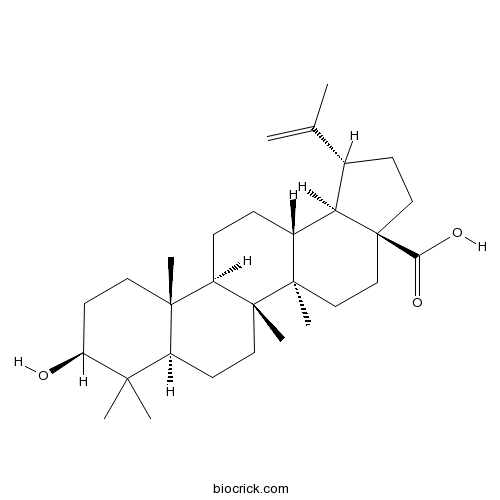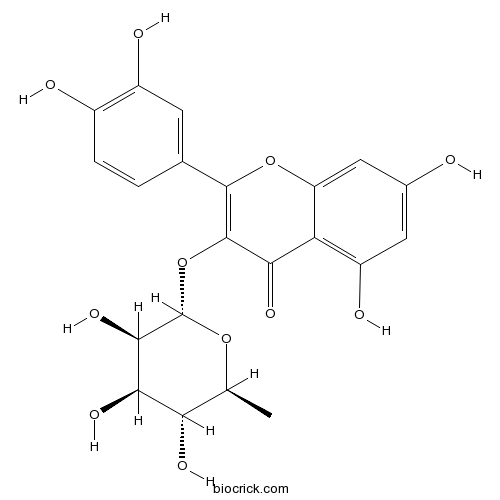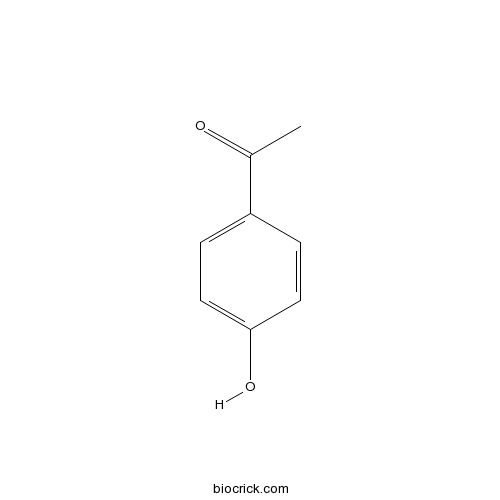Saxifraga stolonifera
Saxifraga stolonifera
1. The products in our compound library are selected from thousands of unique natural products; 2. It has the characteristics of diverse structure, diverse sources and wide coverage of activities; 3. Provide information on the activity of products from major journals, patents and research reports around the world, providing theoretical direction and research basis for further research and screening; 4. Free combination according to the type, source, target and disease of natural product; 5. The compound powder is placed in a covered tube and then discharged into a 10 x 10 cryostat; 6. Transport in ice pack or dry ice pack. Please store it at -20 °C as soon as possible after receiving the product, and use it as soon as possible after opening.
Natural products/compounds from Saxifraga stolonifera
- Cat.No. Product Name CAS Number COA
-
BCN5524
Betulinic acid472-15-1
Instructions

-
BCN5540
Bergenin477-90-7
Instructions

-
BCN5665
Quercitrin522-12-3
Instructions

-
BCN4544
4'-Hydroxyacetophenone99-93-4
Instructions

Development of a LC-MS/MS method to investigate the interference of pharmacokinetics of the main constituents in Saxifraga stolonifera: Involvement of drug metabolism enzymes.[Pubmed: 29017109]
None
Testing the influence of gravity on flower symmetry in five Saxifraga species.[Pubmed: 28361347]
Flower symmetry is considered a species-specific trait and is categorized in asymmetry, actinomorphic symmetry, bisymmetry and zygomorphic symmetry. Here we report on the intra-individual variation of flower symmetry in the genus Saxifraga and the influence of light, gravity and intrinsic factors on the development of flower symmetry. We tested five species-Saxifraga cuneifolia, Saxifraga imparilis, Saxifraga rotundifolia, Saxifraga stolonifera and Saxifraga umbrosa-concerning six flower parameters-angles between petals, petal length, petal pigmentation, angular position of carpels, movement of stamens and (only for S. imparilis and S. stolonifera) the length of the two lower elongated petals in regard to their position towards the stem. Specimens of all species were tested on a vertical clinostat as a gravity compensator, on a horizontal clinostat as a light incidence compensator and on a stationary control. The results show that the angle of incident light has no apparent impact on flower symmetry, whereas gravity affects the angular position of petals in S. cuneifolia and S. umbrosa and the petal colouration in S. rotundifolia. In S. cuneifolia and S. umbrosa, the absence of directional gravity resulted in the development of actinomorphic flowers, whereas the corresponding control flowers were zygomorphic. The development of flowers in S. rotundifolia was not altered by this treatment. The length of the two elongated petals in S. stolonifera and S. imparilis was not affected by gravity, but rather was determined by position of the flower within the inflorescence and resulted in asymmetrical flowers.
Comparative pharmacokinetics of bergenin, a main active constituent of Saxifraga stolonifera Curt., in normal and hepatic injury rats after oral administration.[Pubmed: 28236407]
None
Water-soluble extract of Saxifraga stolonifera has anti-tumor effects on Lewis lung carcinoma-bearing mice.[Pubmed: 27575479]
Saxifraga stolonifera is an evergreen and herbaceous plant well known in Korea, Japan and western China, which has great potential applications in gardening and pharmacology. The aim of this study is to evaluate the anti-tumor effects of S. stolonifera extraction on lung tumors of Lewis mice. By the measurement of MS/MS, we found that there were four main bioactive components in methanol extract of S. stolonifera, including gallic acid, norbergenin, protocatechuic acid and bergenin, and the results of quantitative analysis showed that the contents of gallic acid, protocatechuic acid and bergenin in methanol extract of S. stolonifera were 5.150, 1.492, 24.559mg/g, respectively. Animal experiment showed that the mean tumor weight of Lewis lung carcinoma-bearing mice treated with water-soluble extract of S. stolonifera was obviously smaller than model group (cis-DDP), and its inhibition rate was 49.2%. In addition, histopathological evaluation and immunohistochemical assay confirmed the anti-tumor effects of S. stolonifera. Investigation of four haematological parameters revealed that the Lewis mice fed with S. stolonifera showed good resilience in the level of leukocyte, haemoglobin, blood platelets and red blood cell compared with the model group. In addition, RT-PCR suggested that the relative expression of pro-apoptosis gene p53, Sox and Bax was enhanced, while the relative expression of anti-apoptosis gene Bcl2 was diminished in comparison with model group. These results suggested that water-soluble extract of S. stolonifera has anti-tumor effects on Lewis lung tumors.
A study on ice crystal formation behavior at intracellular freezing of plant cells using a high-speed camera.[Pubmed: 27343136]
Intracellular ice crystal formation (IIF) causes several problems to cryopreservation, and it is the key to developing improved cryopreservation techniques that can ensure the long-term preservation of living tissues. Therefore, the ability to capture clear intracellular freezing images is important for understanding both the occurrence and the IIF behavior. The authors developed a new cryomicroscopic system that was equipped with a high-speed camera for this study and successfully used this to capture clearer images of the IIF process in the epidermal tissues of strawberry geranium (Saxifraga stolonifera Curtis) leaves. This system was then used to examine patterns in the location and formation of intracellular ice crystals and to evaluate the degree of cell deformation because of ice crystals inside the cell and the growing rate and grain size of intracellular ice crystals at various cooling rates. The results showed that an increase in cooling rate influenced the formation pattern of intracellular ice crystals but had less of an effect on their location. Moreover, it reduced the degree of supercooling at the onset of intracellular freezing and the degree of cell deformation; the characteristic grain size of intracellular ice crystals was also reduced, but the growing rate of intracellular ice crystals was increased. Thus, the high-speed camera images could expose these changes in IIF behaviors with an increase in the cooling rate, and these are believed to have been caused by an increase in the degree of supercooling.
Studies on Chromatographic Fingerprint and Fingerprinting Profile-Efficacy Relationship of Saxifraga stolonifera Meerb.[Pubmed: 26703540]
This work investigated the spectrum-effect relationships between high performance liquid chromatography (HPLC) fingerprints and the anti-benign prostatic hyperplasia activities of aqueous extracts from Saxifraga stolonifera. The fingerprints of S. stolonifera from various sources were established by HPLC and evaluated by similarity analysis (SA), hierarchical clustering analysis (HCA) and principal component analysis (PCA). Nine samples were obtained from these 24 batches of different origins, according to the results of SA, HCA and the common chromatographic peaks area. A testosterone-induced mouse model of benign prostatic hyperplasia (BPH) was used to establish the anti-benign prostatic hyperplasia activities of these nine S. stolonifera samples. The model was evaluated by analyzing prostatic index (PI), serum acid phosphatase (ACP) activity, concentrations of serum dihydrotestosterone (DHT), prostatic acid phosphatase (PACP) and type II 5α-reductase (SRD5A2). The spectrum-effect relationships between HPLC fingerprints and anti-benign prostatic hyperplasia activities were investigated using Grey Correlation Analysis (GRA) and partial least squares regression (PLSR). The results showed that a close correlation existed between the fingerprints and anti-benign prostatic hyperplasia activities, and peak 14 (chlorogenic acid), peak 17 (quercetin 5-O-β-d-glucopyranoside) and peak 18 (quercetin 3-O-β-l-rhamno-pyranoside) in the HPLC fingerprints might be the main active components against anti-benign prostatic hyperplasia. This work provides a general model for the study of spectrum-effect relationships of S. stolonifera by combing HPLC fingerprints with a testosterone-induced mouse model of BPH, which can be employed to discover the principle components of anti-benign prostatic hyperplasia bioactivity.
[HPLC fingerprint of ethyl acetate extraction of Saxifraga stolonifera].[Pubmed: 23847951]
To establish an HPLC fingerprint of ethyl acetate extraction of Saxifraga stolonifera.
Various treatment options for benign prostatic hyperplasia: A current update.[Pubmed: 22923974]
In benign prostatic hyperplasia (BPH) there will be a sudden impact on overall quality of life of patient. This disease occurs normally at the age of 40 or above and also is associated with sexual dysfunction. Thus, there is a need of update on current medications of this disease. The presented review provides information on medications available for BPH. Phytotherapies with some improvements in BPH are also included. Relevant articles were identified through a search of the English-language literature indexed on MEDLINE, PUBMED, Sciencedirect and the proceedings of scientific meetings. The search terms were BPH, medications for BPH, drugs for BPH, combination therapies for BPH, Phytotherapies for BPH, Ayurveda and BPH, BPH treatments in Ayurveda. Medications including watchful waitings, Alpha one adrenoreceptor blockers, 5-alpha reductase inhibitors, combination therapies including tamsulosin-dutasteride, doxazosin-finasteride, terazosin-finasteride, tolterodine-tamsulosin and rofecoxib-finasteride were found. Herbal remedies such as Cernilton, Saxifraga stolonifera, Zi-Shen Pill (ZSP), Orbignya speciosa, Phellodendron amurense, Ganoderma lucidum, Serenoa Repens, pumpkin extract and Lepidium meyenii (Red Maca) have some improvements on BPH are included. Other than these discussions on Ayurvedic medications, TURP and minimally invasive therapies (MITs) are also included. Recent advancements in terms of newly synthesized molecules are also discussed. Specific alpha one adrenoreceptor blockers such as tamsulosin and alfuzosin will remain preferred choice of urologists for symptom relief. Medications with combination therapies are still needs more investigation to establish as preference in initial stage for fast symptom relief reduced prostate growth and obviously reduce need for BPH-related surgery. Due to lack of proper evidence Phytotherapies are not gaining much advantage. MITs and TURP are expensive and are rarely supported by healthcare systems.
Chemical constituents of Saxifraga stolonifera (L.) Meeb.[Pubmed: 20939183]
To study the chemical constituents of Saxifraga stolonifera (L.) Meeb., chromatographic techniques were applied to separate and purify the compounds, and their structures were confirmed on the basis of physicochemical properties and spectral data. Ten compounds were isolated and identified as 5-O-methylnorbergenin (1), 3, 4-dihydroxyallylbenzene-4-O-beta-D-glucopyranoside (2), (7R, 8S)-4, 9, 9'-trihydroxyl-3-methoxyl-7, 8-dihydrobenzofuran-1'-propylneolignan-3'-O-beta-D-glucopyranoside (3), quercetin-3-O-beta-D-xylopyranosyl-(1 --> 2)-beta-D-galactopyranoside (4), kaempferol-3-O-alpha-L-rhamnopyranoside (5), (3S, 5R, 6R, 7E, 9R)-3, 5, 6, 9-tetrahydroxy-7-megastigmane (6), benzyl-O-alpha-L-rhamnopyranosyl-(1 --> 6)-beta-D-glucopyranoside (7), p-hydroxyacetophenone (8), pyrogallic acid (9) and p-hydroxyphenol (10). Compound 1 is a new compound. Compounds 2-10 were isolated from this plant for the first time.


